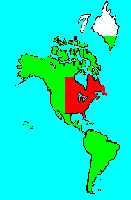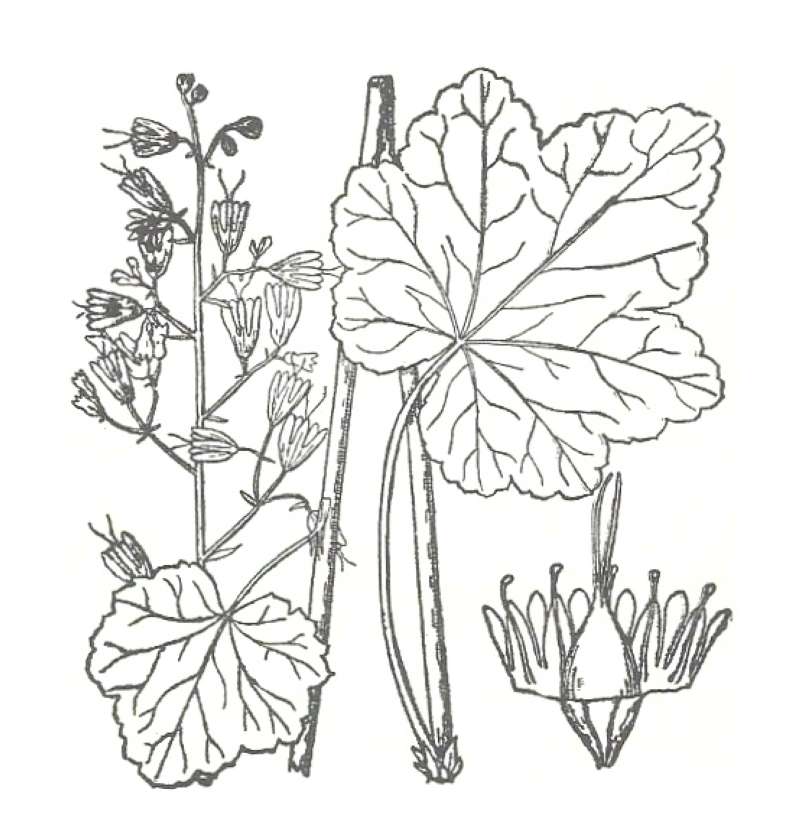SPECIES INFO
Downy Heuchera (Heuchera pubescens) is found in woods from Pennsylvania to Kentucky and North Carolina and west to Missouri. This stout stemmed plant can reach to about 3 feet in height. The 5 to 7 lobed mildly toothed basal leaves are round in outline with a cordate base. They can be up to about 4 inches in width. The flowers are slightly purplish.Heuchera genus is native to North America and Mexico. There are between 50 and 80 species. These are erect or ascending perennial herbs usually with broad basal long-petioled toothed leaves. There are 35 species and 38 named subspecies growing in greater North America.
The taxonomy of the Saxifrage family has been arranged in a number of different ways. Herein, we have separated the herbs into several sub-families, and the woody shrubs into two subfamilies. In this group we are referring to the typical herb saxifrage group.
Saxifrage Family (Saxifragaceae) contains herbs, bushes, and trees found throughout the world. There are about 650 to 1200 species in this family. There is controversy over the limits of this family as various authors define it differently. For example, the Hydrangea and Philadelphus group is frequently given separate family status in the Hydrangeaceae family. The Ribes group is also frequently given family status in the Grossulariaceae family. Kartesz shows 174 species in the Saxifrage family; another 52 species in the Hydrangea family, and another 57 species in the Grossulariaceae family growing in greater North America.)
Herein we have moved many species into various sub-groups in the Saxifrage family. We hope this will help one in the difficult problem of accurate identification, as it will group several similar species near each permitting stepping through a sub-group.
Rose Group (Order Rosales) contains many large and very important families. Included here are fruit trees in the family Rosaceae, the nitrogen fixing plants like clover and alfalfa (in the family Leguminosae), and a large assemblage of plants divided into over fifteen different families.
There has been considerable research in recent years as to the organization of the various plant families into orders. Although we certainly recognize and applaud those who are rearranging the families, we are staying with a more traditional approach for several reasons:
1) The traditional approach is well known, and still exists in many very popular field guides.
2) There are questions as to whether the new organizations are finalized.
3) We recognize there are essentially two different modern systems today: A European one and a North American one.
4) Furthermore, we recognize that most plant families and their boundaries are unchanged. In fact many excellent modern books present the families within the Monocots in a simple alphabetical sequence and the families within the Dicots in a simple alphabetical sequence.
Dicots (Dicotyledoneae Class) are the predominant group of vascular plants on earth. With the exception of the grasses (Monocots) and the Conifers (Gymnosperms), most of the larger plants that one encounters are Dicots. Dicots are characterized by having a seed with two outer shell coverings.
Some of the more primitive Dicots are the typical hardwood trees (oaks, birches, hickories, etc). The more advanced Dicots include many of the Composite (Aster) Family flowers like the Dandelion, Aster, Thistles, and Sunflowers. Although many Monocots reach a very high degree of specialization, most botanists feel that the Dicots represent the most advanced group of plants.
Seed plants (Phylum Embryophyta) are generally grouped into one large phylum containing three major classes: the Gymnosperms, the Monocots, and the Dicots. (Some scientists separate the Gymnosperms into a separate phylum and refer to the remaining plants as flowering plants or Angiospermae.)
For North American counts of the number of species in each genus and family, the primary reference has been John T. Kartesz, author of A Synonymized Checklist of the Vascular Flora of the United States, Canada, and Greenland (1994). The geographical scope of his lists include, as part of greater North America, Hawaii, Alaska, Greenland, Puerto Rico, and the Virgin Islands.
Kartesz lists 21,757 species of vascular plants comprising the ferns, gymnosperms and flowering plants as being found in greater North America (including Alaska, Hawaii, Greenland, Puerto Rico and the Virgin Islands.
There are estimates within the scientific world that about half of the listed North American seed plants were originally native with the balance being comprised of Eurasian and tropical plants that have become established.
Plant kingdom contains a large variety of different organisms including mosses, ferns, and seed plants. Most plants manufacture their energy from sunlight and water. Identification of many species is difficult in that most individual plants have characteristics that have variables based on soil moisture, soil chemistry, and sunlight.
Because of the difficulty in learning and identifying different plant groups, specialists have emerged that study only a limited group of plants. These specialists revise the taxonomy and give us detailed descriptions and ranges of the various species. Their results are published in technical journals and written with highly specialized words that apply to a specific group.
On the other hand, there are the nature publishers. These people and companies undertake the challenging task of trying to provide easy to use pictures and descriptions to identify those species.


